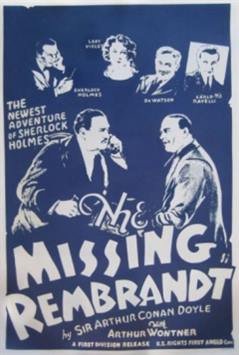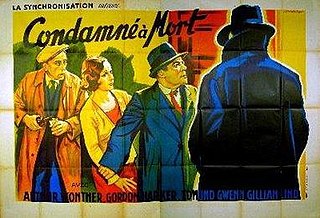Arthur Wontner was a British actor best known for playing Sir Arthur Conan Doyle's master detective Sherlock Holmes in five films from 1931 to 1937.
Bonnie Prince Charlie is a 1923 British silent historical film directed by Charles Calvert and starring Ivor Novello, Gladys Cooper, and Hugh Miller. It is now considered a lost film.
Old Iron is a 1938 British drama film directed by Tom Walls and starring Richard Ainley, Henry Hewitt, Eva Moore and Cecil Parker.

The Sign of Four is a 1932 British crime film directed by Graham Cutts and starring Arthur Wontner, Ian Hunter and Graham Soutten. The film is based on Arthur Conan Doyle's second Sherlock Holmes novel The Sign of the Four (1890). The film is also known as The Sign of Four: Sherlock Holmes' Greatest Case.

Silver Blaze is a 1937 British, black-and-white crime and mystery film, based loosely on Arthur Conan Doyle's 1892 short story "The Adventure of Silver Blaze". It was directed by Thomas Bentley, and was produced by Twickenham Film Studios Productions. It stars Arthur Wontner as Sherlock Holmes, and Ian Fleming as Dr. Watson. In the United States, the film was released in 1941 by Astor Pictures, where it was also known as Murder at the Baskervilles, retitled by distributors to capitalize on the success of the Basil Rathbone Holmes film, The Hound of the Baskervilles.

The Triumph of Sherlock Holmes is a 1935 British mystery film directed by Leslie S. Hiscott and starring Arthur Wontner. It was based on the 1915 Sherlock Holmes novel The Valley of Fear by Arthur Conan Doyle.

The Missing Rembrandt is a 1932 British mystery film directed by Leslie S. Hiscott and starring Arthur Wontner, Jane Welsh, Miles Mander, and Francis L. Sullivan. It is considered a lost film. The film was loosely based on the 1904 Sherlock Holmes story "The Adventure of Charles Augustus Milverton" by Arthur Conan Doyle.

Kate Plus Ten is a 1938 British thriller film directed by Reginald Denham and starring Jack Hulbert, Genevieve Tobin and Noel Madison. It was adapted from the Edgar Wallace novel Kate Plus Ten. It was also released as Queen of Crime.
Sherlock Holmes is a film series running from 1931 to 1937. Arthur Wontner portrayed Sherlock Holmes in five films.
The Diamond Man is a 1924 British crime film directed by Arthur Rooke and starring Arthur Wontner, Mary Odette and Reginald Fox. It was based on a novel by Edgar Wallace. The movie is silent and black and white. Distributed by Butcher's film service, script written by Eliot Stannard, and produced by I.B. Davidson Film Company.

Condemned to Death is a 1932 British crime film directed by Walter Forde and starring Arthur Wontner, Gillian Lind and Gordon Harker. It was adapted from the play Jack O'Lantern by James Dawson which was itself based on a 1929 novel by George Goodchild.

Lady Windermere's Fan is a 1916 British silent comedy film directed by Fred Paul and starring Milton Rosmer, Netta Westcott and Nigel Playfair. It was the first film adaptation of Oscar Wilde's 1892 play Lady Windermere's Fan. A print of the film still exists and it has been released on DVD by the British Film Institute.
Walter Tennyson (1899-1980) was a British actor and film director of the silent and early sound era.
Eugene Aram is a 1924 British silent drama film directed by Arthur Rooke and starring Arthur Wontner, Barbara Hoffe and Mary Odette. It was based on the 1832 novel Eugene Aram by Edward Bulwer-Lytton which depicts the life of the eighteenth century criminal Eugene Aram.
Second Bureau is a 1936 British spy romance film directed by Victor Hanbury and starring Marta Labarr, Charles Oliver and Arthur Wontner. It was made at Shepperton Studios and based on a novel Second Bureau by Charles Robert-Dumas. It was a remake of a 1935 French film of the same name.

Ruby Miller was a British stage and film actress. Originally one of George Edwardes’ ‘Gaiety Girls’, she was the subject of TV's This is Your Life in 1962. In June 1966 she appeared in the final ABC production of the popular series Thank Your Lucky Stars with a rendition of the song "Stop and Think".
The Call of the East is a 1922 British silent adventure film directed by Bert Wynne and starring Warwick Ward, Doris Eaton and Walter Tennyson. It is also known by the alternative title of His Supreme Sacrifice.

Twilight Hour is a 1945 British drama film directed by Paul L. Stein and starring Mervyn Johns, Basil Radford, and Marie Lohr. It was shot at the British National Studios in Elstree. The film's sets were designed by the art director Wilfred Arnold. It was based on a novel of the same title by Arthur Valentine
Nothing Like Publicity is a 1936 British comedy film directed by Maclean Rogers and starring William Hartnell, Marjorie Taylor and Moira Lynd. It was made at Walton Studios as a quota quickie.
The Live Wire is a 1937 British comedy film directed by Herbert Brenon and starring Jean Gillie, Irene Ware and Arthur Wontner.








